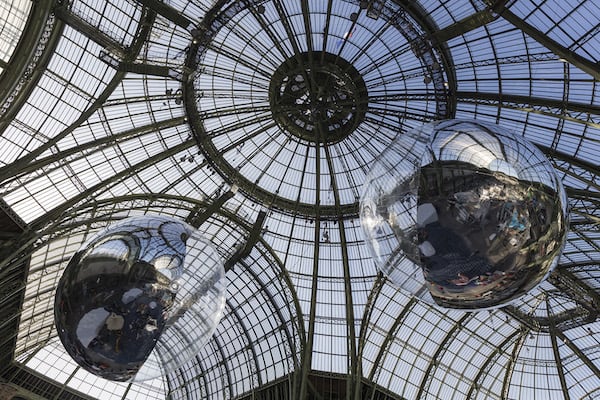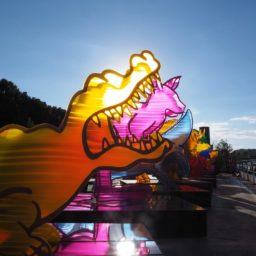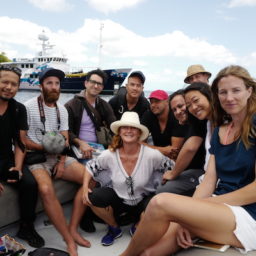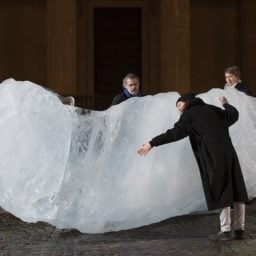“We are all flying, we are all floating—don’t you know that?” smirked Argentine artist Tomás Saraceno on Friday at Paris’ Grand Palais, where press had assembled for the debut of his floating Aerocene sculptures, air-filled spheres powered only by the sun that he created to circumnavigate the planet. “Earth is always traveling,” he went on, “and it’s good to be aware that we are on such a ship. Like any ship, ours has a limited amount of resources, and we need to take stock of that, or this ship will stop being a place where we can survive.”
It was a fittingly eco-conscious opening statement for a work unveiled in conjunction with the United Nations Climate Change Conference COP21, which descended upon the City of Lights last week and continues through December 11. Featuring hundreds of lectures, presentations and roundtables, the 21st edition of the global initiative has brought representatives from 190 countries together to negotiate a legally binding agreement on climate regulation that will keep global warming below 2°C.
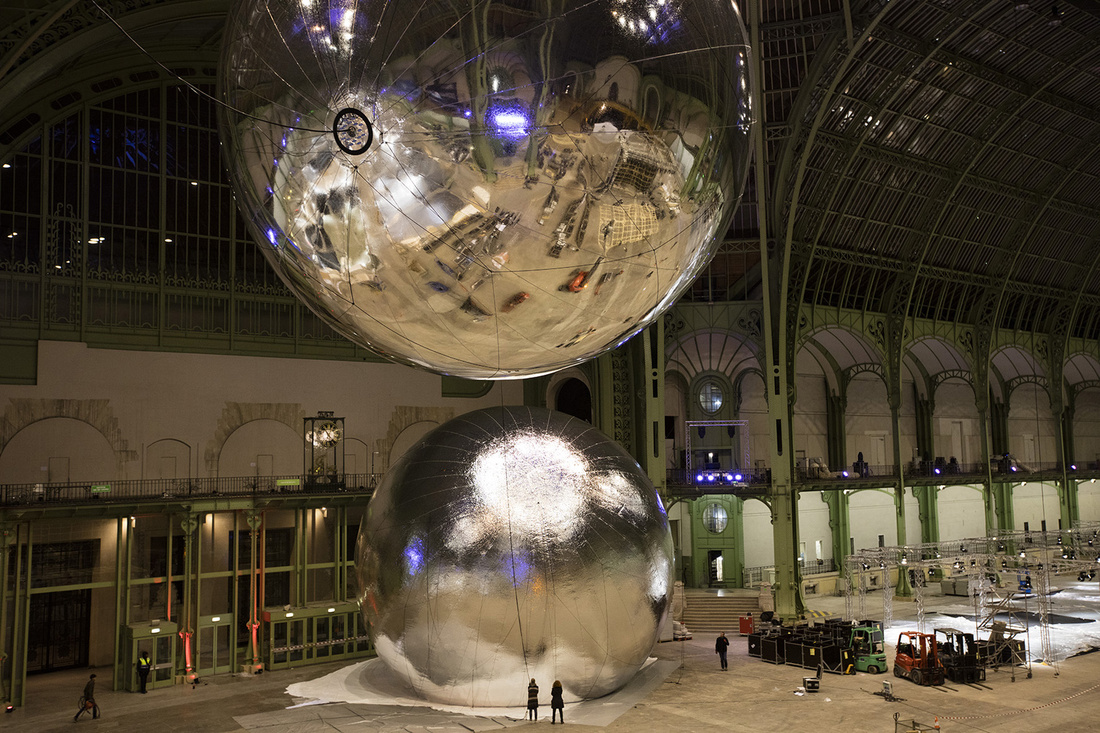
Tomas Saraceno Aerocene 2015, Installation view at Grand Palais
Photo: courtesy Tanya Bonakdar, New York; Andersen’s Contemporary, Copenhagen; Esther Schipper, Berlin. Photography Studio Tomás Saraceno
Berlin-based Saraceno is one of many artists invited to participate—Olafur Eliasson and Liam Gillick are others among them—and he is known for interactive sculptures and installations that combine engineering, art, architecture, and the natural sciences to propose sustainable ways of engaging with the environment. Aerocene, conceived during his ongoing residency at the French National Space Agency (he was also a resident artist in NASA’s Aims Program in 2009), constitutes the culmination of that interest. “We artists are on top of science exploration, of technology, of understanding the cosmos,” he said. “I hate the idea of knocking on the door to NASA and saying, ‘Hey, can I?’ Because we can do it already. But with their help, we can do it better.”
Powered only by the Sun’s heat, these thin aluminum globes rise up to 40 kilometers above the earth during the day and descend at night in graceful arcs, their delicate skins responding to slight changes in atmospheric temperature. But even in the dark they continue to float above ground, lifted by infrared radiation from the planet’s surface. “We are told that a shift of 2 degrees will destroy us,” Saraceno added, “but that feels intangible to us. I think this sculpture visually manifests how much subtle changes can do.”
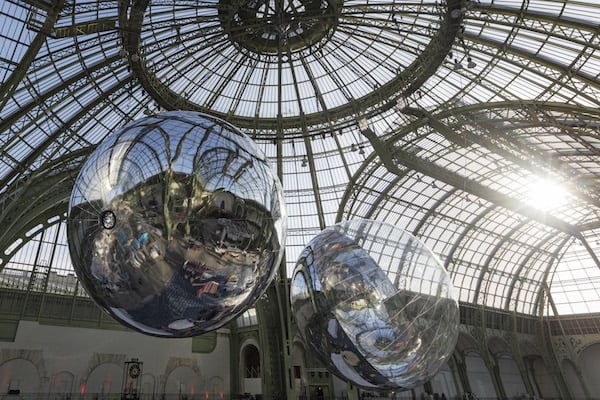
Tomas Saraceno Aerocene 2015, Installation view at Grand Palais
Photo: courtesy Tanya Bonakdar, New York; Andersen’s Contemporary, Copenhagen; Esther Schipper, Berlin. Photography Studio Tomás Saraceno
As they work without batteries, helium, solar panels, or the burning of fossil fuels—technology already tested by the French in the 1970s, and then largely forgotten—Saraceno insists that these sculptures represent a new era, the Aerocene era, which will have to follow the geologic destruction we have wrought during the Anthropocene epoch. “We want to spark a thermodynamic imagination,” he says, “opening up a space confined at the moment for military purposes to other fields in science, art, and beyond.”
Beyond their use as research tools that help us understand wind patterns and jet streams, he expects them to revolutionize transportation. “Only 12 people in human history have been able to be lifted by the sun,” he says, explaining that he recently used a small model to travel the 500 kilometers between Berlin and Poland in 5 hours, “without burning even one drop of fuel”—winning two world records for balloon travel. “The only danger is to keep flying the way we fly today,” he says, “when with jet streams we have a constant highway in the sky for free. I even hope to introduce a system of club miles and memberships.”
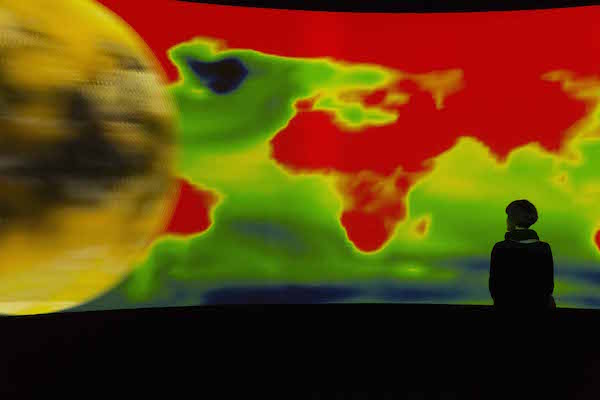
EXIT 2008-2015 Installation view at Fondation Cartier pour l’art contemporain, Paris
Photo: ©Luc Boegly ©Diller Scofidio + Renfro, Mark Hansen, Laura Kurgan and Ben Rubin, in collaboration with Robert Gerard Pietrusko and Stewart Smith
The planetary degradation suggested by Saraceno’s project is tackled from a different angle by EXIT, a stunning video installation conceived by French philosopher and urbanist Paul Virilio with Diller Scofidio + Renfro architects, working with a team of statisticians, artists and scientists. Commissioned in 2008 by the Cartier Foundation but reprised at the Palais de Tokyo with updated information, this 45-minute, 360° projection of animated and thematic maps visually explores human migrations today and their leading causes, drawing on a wide array of sources and statistics borrowed from international organizations, NGOs and research centers, none of whom were invited to vouch for or endorse the information.
Divided into six chapters—Cities; Remittances; Political Refugees and Forced Migration; Natural Catastrophes; Rising Seas, Sinking Cities; and Deforestation—the maps are ingenious, utilizing simple graphics such as flags and colored pixels to manifest complex human issues. The passage of months and years is expressed both by dates, which click by at the bottom of the screen like the pages of a calendar, and by a harrowing soundtrack that evokes a ticking time bomb, allowing viewers to compare and contrast. And yet the work avoids dogmatism.
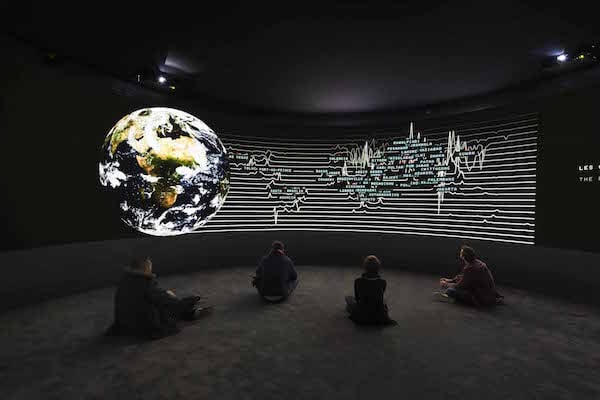
EXIT 2008-2015 Installation view at Fondation Cartier pour l’art contemporain, Paris
Photo: ©Luc Boegly ©Diller Scofidio + Renfro, Mark Hansen, Laura Kurgan and Ben Rubin, in collaboration with Robert Gerard Pietrusko and Stewart Smith
Both captivating and disturbing, all six maps demonstrate a connection between humans and their environment that has degenerated considerably over the past seven years. Equal populations now live in cities and the countryside, a veritable disaster for greenhouse gas emissions; remittances sent home from immigrants living abroad constitute three times those countries’ foreign aid; and the amount of global refugees and Internally Displaced People has reached nearly 60 million, the highest it has been since the end of World War II. Addressing human problems rarely seen within the bubble of the art world, EXIT paints a dire picture of the present—and suggests a dark future.
“There is no such thing as hard data or objective data but we tried to get our hands on the most reliable data sources available,” Liz Diller says. “And it can produce empathy, alarm, and awe when given form.”
